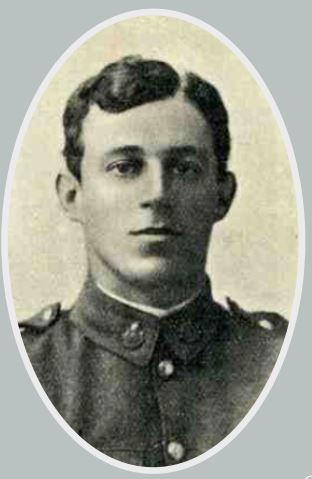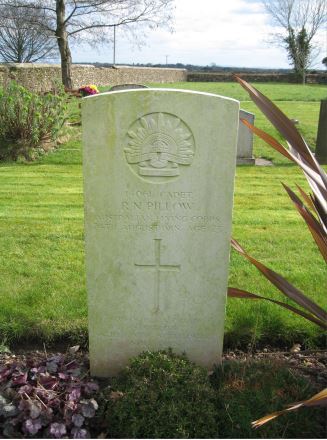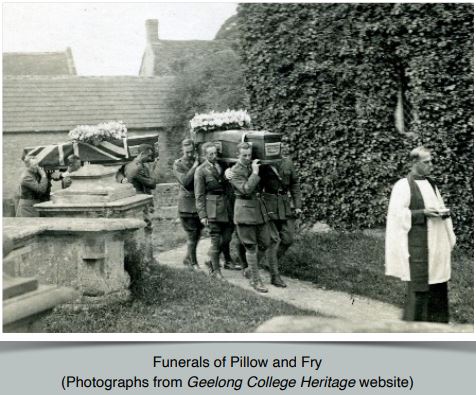7th Training Squadron, Australian Flying Corps

Roy Nelson Pillow was born on 18 December 1894, the son of Henry and Harriet Pillow of Minerva, Herne Hill, Geelong, Victoria (latterly Laurel Bank Parade, Geelong).
He was educated at Geelong College, between 1909-14 and their heritage website gives some detailed information on the time he spent there. It appears he was a fine athlete and all-round sportsman: academically he excelled at chemistry and went on to study medicine at Ormond College, Melbourne University. He also served as a Cadet in Captain Rushall’s Mounted Cadets and a Sergeant Major in Melbourne University Rifles.
On 3 August 1915 he enlisted into the Australian Army, when a medical student and was assigned to the Australian Army Medical Corps as a Private (number 14061) on 8 September 1915. A posting to No 3 Australian Casualty Clearing Station followed on 17 March 1916.
He embarked from Sydney on 5 June 1916, aboard the HMAT Borda (A30), arriving in Southampton on 23 July 1916. Just over two months were spent in the UK before he was posted to France and to the Special Operating Hospital at Authie on 12 October.
His transfer to the Australian Flying Corps (AFC) and the No 2 School of Military Aeronautics, Oxford. Following a further instructional course at the Royal Air Force Armament School, Uxbridge, he was posted, as a Cadet, to 7th Training Squadron at Leighterton, on 6 June 1918. Although having qualified to train as a pilot, he still held the rank of Air Mechanic Second Class: had he lived, no doubt, upon completion of pilot training he would have been gazetted as a Second Lieutenant.
On 22 August 1918 he survived a crash at Leighterton, when flying a RE8 (serial no.C2627). He was practising formation flying and at 1.55pm was returning to the aerodrome. From the height of about 150 feet he attempted to turn right and side slip into the aerodrome. In his evidence to the Court of Inquiry into the accident Roy stated that he felt the right wing bump up and the aircraft appeared to go into a flat spin. He had no recall of subsequent events and was fortunate to survive a crash landing, sustaining only slight concussion and some small facial lacerations. This was his first mishap and he was considered a competent flier.
He was less fortunate two days later.
On 23 August, the day following his crash, he went aloft with his instructor, under dual control. He handled the machine well and was keen to fly solo again. On the 24th he took off once more in a RE8 (serial no 4977), to take part in a formation flying exercise. A witness at the Court of Enquiry stated that at about 11.40am he saw Pillow’s aircraft making a left hand turn, at a height of about 100 feet, at a low flying speed. The nose of the aircraft dropped and it went into a vertical spin to the ground. Cadet Pillow died instantly upon impact. He was 23 years of age.
The circumstances of his fatal crash appeared very similar to the 22 August crash. In the opinion of his CO, Roy had been showing good performance as a pilot and should have learnt from what went wrong on the 22nd and that possibly he had blacked out at a vital moment.
Cadet Roy Pillow was buried in Leighteron Church Cemetery on 28 August 1918, along with Second Lieutenant Sydney Charles Fry, who had also died in an air crash on the same day. Several former students of Geelong College were in attendance, along with his brother Albert Ernest Pillow, in England undertaking war work. A CWGC headstone now marks his grave.
The authorities did report that another brother, 568 Private Henry Fenton Pillow MM, attended the funeral. However, this is clearly untrue as he had died of wounds sustained at Herleville, about 22 miles east of Amiens, on 18 August 1918, whilst serving with 24th Battalion, Australian Infantry. He is buried at Daours Communal Cemetery Extension.


Researched by Graham Adams 7 February 2018
